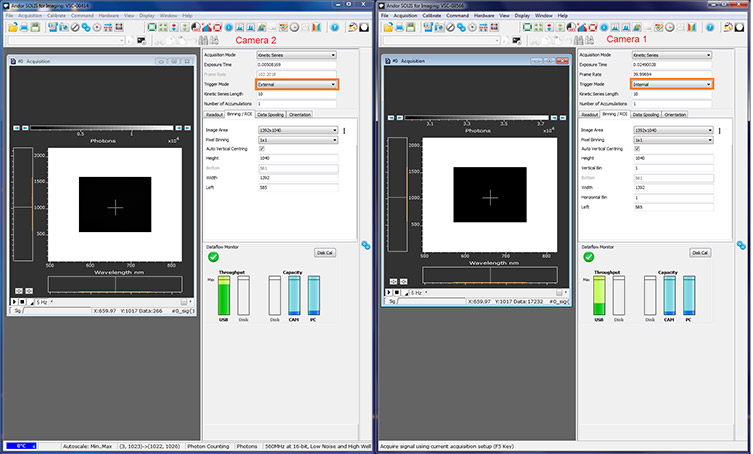


#Andor solis triggered series software
However, be aware that MetaMorph does not have the functionality to set an internal trigger for one camera and an external trigger for the second camera, thus cannot be configured in a ‘Master and Peripheral’ arrangement.īoth cameras can be internally triggered by the software or externally triggered by a device trigger (e.g.

MetaMorph is capable of operating multiple cameras within one instance of software and is therefore very well suited for use with TuCam. Simultaneous Imaging with two detectors using MetaMorph software (version 7.7.8) Note: If you want to achieve fastest possible acquisition speeds when running two iXon Ultras in Solis or iQ, ensure that both cameras are set up to operate in frame transfer mode and crop mode. With this set-up both cameras will run simultaneously with the same frame rate in both Solis and iQ.Īs mentioned, the alternative is to use an external trigger on both cameras to achieve simultaneous and synchronous imaging in both Solis and iQ. This needs to be as close to zero as possible to ensure synchronous acquisition, so ideally input zero here. The exposure setting for camera 2 becomes the delay between camera 1 acquiring its internal trigger and sending a pulse to camera 2 to acquire. In the ‘Master - Peripheral’ mode, the exposure for camera 2 does not need to be set as it depends on the pulses from camera 1 to start acquiring images. In order to achieve the fastest possible acquisition speed from both cameras, set the exposure of camera 1 to be the same as the readout, otherwise set the exposure to be longer. A general rule of thumb is to set the exposure of camera 1 to be the same or longer than the read-out of the sensor (see Figure 1, the iQ set-up). This is important because if the exposure for camera 1 is too short there won’t be sufficient pulses available to trigger camera 2 to acquire all of the images in a kinetic series.

The exposure of camera 1 needs to be set marginally longer than the exposure of camera 2. In this mode camera 2 will wait for camera 1 to trigger it to capture images. Using the trigger cables supplied with the camera, attach the ‘Fire’ cable of camera 1 (Master) to the ‘External Trigger’ cable of camera 2 (Peripheral) via a BNC connector. In the software set the trigger of camera 1 to be internal and that of camera 2 to be external (see Figure 1). Setting up ‘master’ and ‘peripheral’ configuration in Solis and iQ for simultaneous imaging using two Neo sCMOS cameras. red) and camera 2 was receiving the reflected or shorter wavelengths of light (e.g. Camera 1 was attached to the end of the TuCam receiving the longer wavelengths of light (e.g. In the acquisition testing (described later), the Master and Peripheral set-up was employed, whereby camera 1 (Master) will trigger camera 2 (Peripheral) to acquire images. Each software is capable of synchronizing the cameras under a ‘Master and Peripheral’ arrangement or alternatively a simultaneous external trigger can be provided to both cameras. In order to set up the cameras to acquire simultaneously and synchronously in either Solis or iQ, two instances of the software are required to be open, one for each camera. Simultaneous Imaging with two detectors using Andor Solis (version 06) and Andor iQ (version 2.6) a Master and Peripheral set-up, or can you externally trigger both detectors to acquire frames simultaneously?


 0 kommentar(er)
0 kommentar(er)
